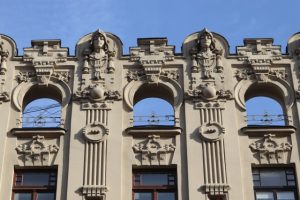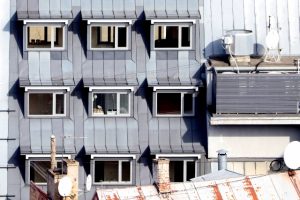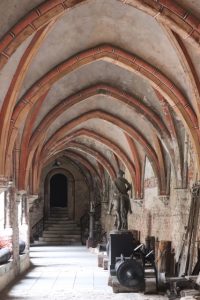There are two parts of Riga that are of interest to the casual visitor, or three, actually. The big two are Central Riga, with its long, straight streets lined with Art Nouveau buildings, and Old Riga, the old town with its cobbled, twisted and turning alleys, and chaotic mix of architectural styles.
Although we intended to start in Old Riga, our hotel is actually outside the old town, in the diplomatic quarter, which also happens to be the main area for Art Nouveau buildings. And of course we cannot resist, so for the next few hours we wander the streets, with oohs and ahhs at each and every discovery of yet another fabulous building, quirky balcony, imposing door or ostentatious decoration. Especially the latter is a recurring factor, more than in Helsinki, or in earlier Art Nouveau encounters we had; the buildings have a multitude of stucco faces, or sculptures (I will put together an architectural porn collection), or other external decorations, that take the focus away from the modernist design style of the houses, the facades. I can tell you all about this, but the photos are probably a more efficient way to show – and otherwise there are lots of far more scholarly books you could check out. Point is, we are just enthusiastic amateurs. But boy, did we enjoy this part of Riga, dubbed the Art Nouveau capital of the world. Oh, and like any town in this part of the world, the wooden houses are just in between the rest of the buildings; even in the Art Nouveau quarter, there are, admittedly upmarket, wooden houses to be found, too. More Riga Art Nouveau here.
Of course, not all buildings are Art Nouveau, but some are equally impressive, in their own way.

the House of the Blackheads, originally 14th Century, bombed during WWII, demolished by the Soviets, and meticulously rebuilt at the end of the 20th C
Old Riga then. Established as a major city at the beginning of the 13th century, by one bishop Albert, who came with the Brothers of the Sword, it went on to become a major trading centre throughout the Middle Ages, no matter who controlled the territory. The city itself was largely controlled by the Baltic Germans, who dominated commerce – until 1939, when many of them were resettled in Germany and Poland as part of a Nazi repopulation initiative, and 1940, when the Molotov-Ribbentrop pact brought the then independent Baltic states under Soviet influence, which made the remaining Germans flee (and the ones who didn’t, subsequently disappeared into Soviet camps). After which the Germans returned in 1941 – but not the Baltic Germans – and were kicked out again by the Russians in 1944, the vagaries of WWII. All of this damaged not only the infrastructure of Riga, which got badly bombed during the war, but also the minds of the Latvians, some of whom fought initially with the Nazis against the occupying Russians, others subsequently against the occupying Nazis. (In all this it is actually easy to forget that the Liberty Monument, at the intersection between Central Riga and the Old Town, remembers those fallen during the fight in 1918-1920, for the establishment of the first independent Latvia.)
All of this has left an Old Town with a huge variety of older and newer buildings, from the old Dom cathedral originally from 1211, but frequently added to since, and the gothic Saint Peter’s church, with its viewing platform – fabulous views! – at 72 meters above the town, to individual houses from all times. Some 16th century, 17th century, but also further Art Nouveau examples. I read somewhere that in each and every street of Riga’s Old Town you may find an unexpected surprise, and we did, in the form of a window, a statue, or just a sculpture of a young man reading a book, draped in a Ukrainian flag (support for Ukraine, in Riga but also earlier in Estonia and Finland is quite universal, and clearly expressed).
Next: more Riga.











































